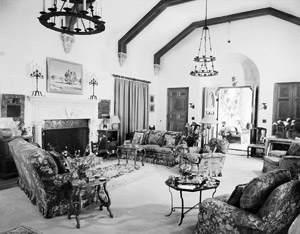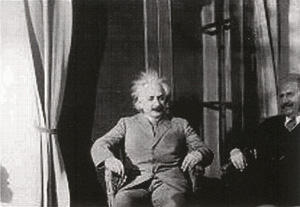The Willows History
History Happened Here…and Still Does
Holding a unique and storied place in the history of Palm Springs, the Willows Historic Palm Springs Inn has stood proudly as one of the area’s most important and beloved landmarks for upwards of a century. Bearing a coveted “Class 1” historic designation by the City of Palm Springs, the Willows is recognized today as one of the ten oldest historic sites in the city. And what a history it has had.
World travelers of wealth and exquisite taste, William and Nella Mead expected their desert retreat to be no less exceptional and to achieve their goal they engaged one of Southern California’s foremost architects, William J. Dodd of the firm of Dodd & Richards to plan the home they would call The Willows. The choice of the talented Dodd was a wise one. Renowned for his skillful designs of structures both residential and commercial, Dodd was particularly adept at creating classically elegant estates including the famous Danziger mansion crowning the top of Bel-Air and homes for such luminaries as Cecil B. De Mille and author Gene Stratton Porter.

For the Meads, Dodd crafted a stately Mediterranean villa, which fit in beautifully with the stark desert hillside into which it was built. Completed in 1925, the Willows was everything the exacting Meads had envisioned, a spectacular home in a spectacular setting with views stretching out across the entire Coachella Valley and located just a stone’s throw from Nellie Coffman’s world famous Desert Inn. As often as their busy lives would allow, the Meads would escape to the Willows, usually joining their great friends the Roland P. Bishops who had built an adjoining mansion, also designed by the talented Dodd, immediately adjacent. Sadly, the Meads were to enjoy their beloved desert paradise for but a few short years before William Mead’s unexpected death by pneumonia in November of 1927 at the age of 65.
The Willows was never the same without her husband and at the end of the 1920’s Nella Mead decided to sell, turning the keys over to another man of great prominence, legendary New York attorney Samuel Untermyer. One of the great “superstar” lawyers of his day, the Virginia-born Untermyer had been the first lawyer ever to attain a $1,000,000 fee, a figure he no doubt well deserved. A brilliant legal mind and courtroom tactician, Untermyer gained his greatest fame in corporate law, first as an advocate for the great corporations and later in opposition to them, taking on the giants of the day including John D. Rockefeller, Henry Ford and J.P. Morgan. Like William Mead before him, Untermyer was also heavily involved in civic, political and social causes and was a powerful and outspoken advocate against Anti-Semitism and the rise of Adolph Hitler.


As fierce an opponent as Untermyer could be in the courtroom, he was as delightful a host at his beloved Willows, taking great joy in opening up his beautiful home to a wide circle of friends that included New York City’s legendary playboy mayor Jimmy Walker and United States Senator and son-in-law of President Woodrow Wilson, William Gibbs McAdoo. A guest at the Willows in the 1930’s was just as likely to meet one of FDR’s cabinet secretaries wandering the lush gardens as a major Hollywood movie star, sometimes both at once as in the time Shirley Temple was brought by to meet New York Governor Herbert Lehman. But the Willows’ most legendary guest was neither politician nor movie star – he was simply a genius. One of the most iconic and important figures in all history, Dr. Albert Einstein, was a good friend of Samuel Untermyer.
Einstein was enchanted by the soothing desert and by the Willows in particular, frequently coming to the hideaway with his wife Elsa even when Untermyer himself was away on business. The great thinker found peace and repose at the Willows, enjoying “sunbaths” in the nude and gazing out at the changing landscape from his favorite bench, still in place, in the hill above the Willows.
Samuel Untermyer’s love affair with the Willows would last until his death at the age of 82 in 1940. For the next two decades, the Willows was carefully maintained by Untermyer’s family as a winter retreat, renting it out on occasion as well. In the mid-1950’s, the Willows was taken over by a famous tenant – Marion Davies. While many know Davies as a movie star and long time mistress of publishing magnate William Randolph Hearst, few realize she was also a brilliant businesswoman and real estate speculator. In 1955, she was part of consortium of investors who bought the fabled Desert Inn. With its location directly adjacent to the hotel, the Willows made a perfect headquarters for Davies and a charming venue for entertaining such famous friends as Mary Pickford and her husband Buddy Rogers.
Over the next several decades, the Willows changed hands a number of times bringing with it inevitable alterations until, by the mid 1990s, the once grand home had lost much of its original luster. Instantly recognizing it for the historic treasure it was, two Emergency physicians from Los Angeles decided to rescue the forlorned estate and return it to its former glory. After an extensive and exhaustive multi-year restoration, the Willows has been reborn as an exclusive intimate luxury hotel, ready again to charm visitors and make history, this time your history.
Historical Articles
This list of articles contain more information on The Willows and its early owner, Samuel Untermyer. You can see more press that The Willows has received by browsing these posts.
- Californians Escape to the Desert, National Geographic, November 1957
- A Picture Journey Through California, Southern Pacific Company
- The Boutonnieres of Mr. Untermyer, The New Yorker, May 18, 1940
- Untermyer Dead in His 82nd Year; Long Had Been Ill, The New York Times, March 17, 1940
- To the Desert for Sun and Air!, Physical Culture, August 1932
- Orchid-Lover, Nature Magazine, January 1931
- Little Giant, Pt. 1, The New Yorker, May 17, 1930
- Little Giant, Pt 2, The New Yorker, May 23, 1930
- Facing the Worst, The New Yorker, May 14, 1927
- Front Page Stuff, American Mercury, February 1927
- Talk of the Town, The New Yorker, June 16, 1926 (PDF)

